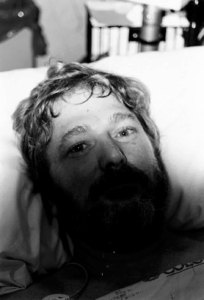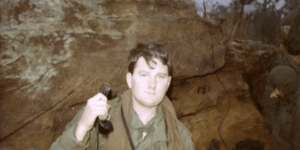
On January 12th, 1998, 49 year old Andrew Howard Brannan was pulled over for speeding by rookie Deputy Sheriff Kyle Dinkheller. What began as a routine traffic stop quickly escalated: Brannan became agitated as the officer ordered him to keep his hands out of his pockets. A verbal altercation ensued with Brannan exhibiting bizarre behavior, telling the officer to shoot him, waving his arms in the air, and jumping around in the middle of the road. Despite numerous orders from Officer Dinkheller to cease this behavior and walk towards the police car, Brannan ignored him. Brannan walked back to his truck and ignored commands for about 40 seconds before retrieving a semi-automatic M1 Carbine rifle from underneath his driver’s seat. Although well within his rights to shoot Brannan, Officer Dinkheller hesitated. Now holding the rifle and placing his head directly in the line of fire, it is safe to assume that Brannan was trying to commit suicide. But then, something in Brannan seemed to snap. Brannan, a decorated Vietnam combat veteran appears to go into combat mode, taking cover and moving his head and rifle unpredictably to avoid being shot. Brannan fired several shots prompting officer Dinkheller to return fire. Dinkheller, armed with a 9mm pistol, had to reload first. When this happened, Brannan rushed Dinkheller’s vehicle, shooting the officer multiple times. Brannan approached Dinkheller and stood over him before delivering the fatal shot through the officer’s right eye. Officer Dinkheller was hit 9 times in total. Brannan then drove away from the scene.
The following morning, Brannan was apprehended by police telling investigators, “they can hang me.” After pleading not guilty by reason of inanity, Brannan was found guilty of murder in January 2000 and sentenced to death. In 2015, Brannan was executed in Georgia via lethal injection.

Now that you know Brannan’s story and the outcome, the question is–why? On its face this question may seem absurd. If you kill someone, you should either get life in prison or the death penalty…right? Vietnam, as the first war to be televised, gave some watching from home the false perception that they understand what war is like. In reality, only those who experienced it could understand the realities of war and the effect it has on the human mind. Andrew Brannan served in Alpha Company of the 23rd Infantry Division of the United States Army. In 1968, 21 year old Brannan took point for the platoon that was the first to enter battle in Huế, Vietnam. This meant that he was the first person who would be exposed to combat in the first platoon to enter battle. That day, Brannan watched his platoon leader get blown to bits by a land mine. His actions in this battle earned him a bronze star for courage under fire. He was then redeployed to Vietnam where he went on to earn his second bronze star for bravery in combat. In total, Brannan lost 14 comrades over the course of his service before he was discharged from the army and sent home with what was later diagnosed as severe PTSD (post traumatic stress disorder). Soon after his return home, Brannan’s brother and fellow Vietnam veteran killed himself. A few months after this, Brannan’s older brother, also a Vietnam veteran, was killed in a plane crash while on an Army training assignment.
At this point, there is no bout that Brannan was experiencing an extreme mental breakdown and suffering from severe PTSD. During this mental breakdown, Brannan locked himself away for about 2 years. His family found it difficult to engage him in conversation, describing Brannan as loudly blurting out details of his combat at random and talking to people who were not there. Brannan’s family got him a dog in a desperate attempt to help him. This seemed to considerably improve Brannan’s condition and by all reports, Brannan adored this dog. This leads us to January 12th, 1998, when Officer Dinkheller pulled over Brannan on his way home from walking his dog. At this point, Brannan had not refilled his prescriptions in 2 weeks, the longest he had gone without medication since being diagnosed with PTSD.

Brannan’s crime was horrific and reprehensible, yet the origins of his actions on January 12th, 1998 were plain to see. This was a man who was called to duty by the United States Army and did not hesitate to risk everything for his country and the freedom of those back home. Brannan served valiantly and like so many soldiers, upon returning home, found himself abandoned by the very people who had sent him to the front lines of war. Numerous United States Marine and Air Force Veterans appealed for leniency for Brannan. As you now know, their requests fell on deaf ears. Brannan received no such sympathy. PTSD was, at the time of Brannan’s trial, a recognized psychiatric condition which often granted defendants similar leniency to someone diagnosed with a severe mental disorder. There was also no shortage of evidence that Brannan’s PTSD was legitimate and of the most severe variety, stemming from his time in theater. Thus, a question arises: What makes Brannan’s case different? Why is it that Brannan received no leniency when in numerous other cases of violent crimes, defendants, including veterans with PTSD and other mental disorders have received relatively light sentences?
Most people familiar with this case agree that the answer comes down to a single element of Brannan’s case: The medium of video. Video footage has the ability to augment a scenario and make it more life-like. It allows an audience of jurors to not merely imagine the situation in question, but to actually experience it almost as if they were the victim. Video, especially in the context of criminal trials, changes a crime from words on a page, conveyed by an attorney through a verbal description, into something far more visceral. At this point, it is important to note that the entirety of Brannan’s interaction and crime that day were caught on the vehicle dash camera of Officer Dinkheller. In order to understand exactly why Brannan’s pleas for leniency were rejected outright, despite the extraordinary circumstances of his life and service, you may (or may not) wish to view this video footage. (VIEWER DISCRETION ADVISED!).
Whether or not you choose to view the video footage, what do you think about the case of Andrew Brannan? Do you think he deserved his punishment? If so, how do we square this with the leniency shown to other offenders who have committed similar or worse crimes but who have been shown mercy? If not, how do we reconcile compassion for a person’s unfortunate life experiences with the incalculable suffering they caused? Was this a failure of our justice system and Veteran Affairs? Or does the responsibility ultimately fall on Brannan? Just before being executed by the state of Georgia, Brannan stated, “I extend my condolences to the Dinkheller family, especially Kyle’s parents and his wife and his two children.” Let me know your thoughts in the comments and thank you for reading.






